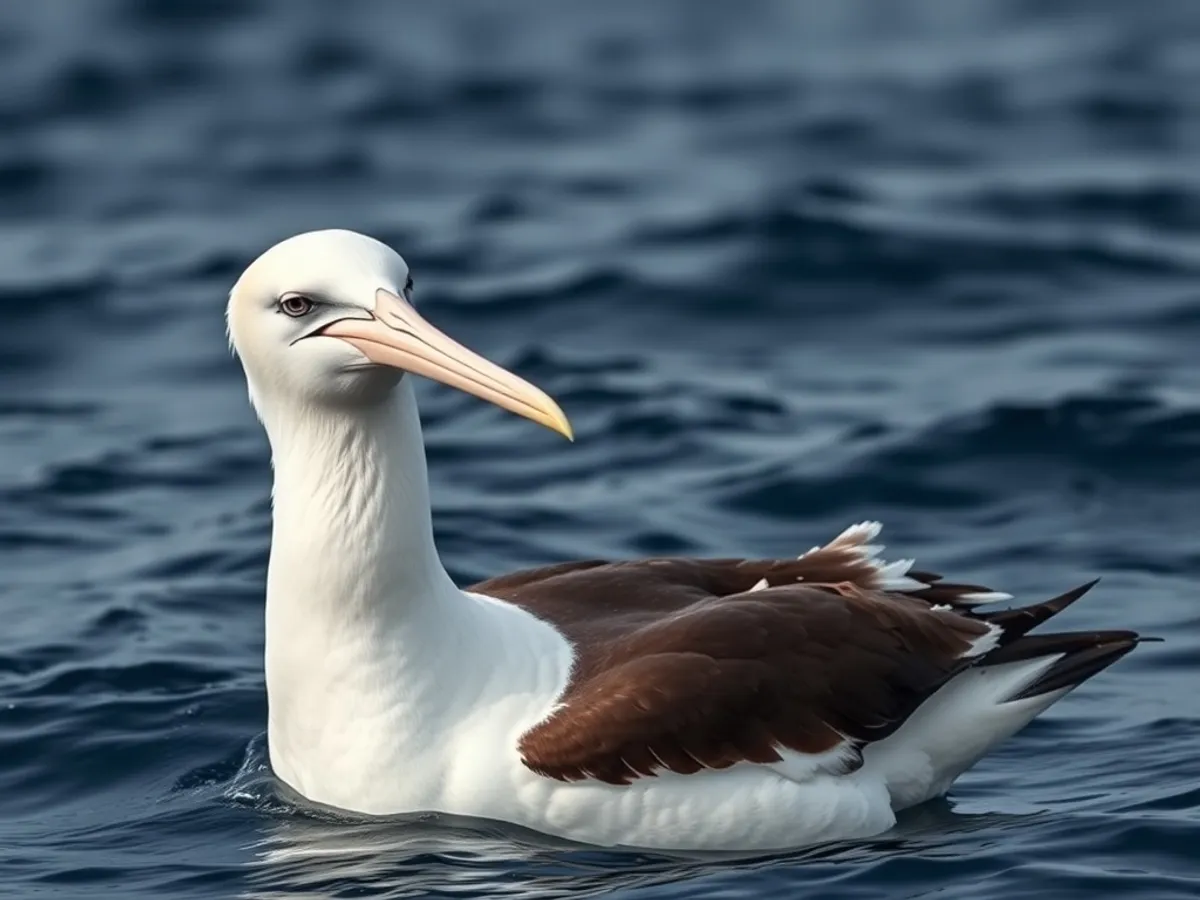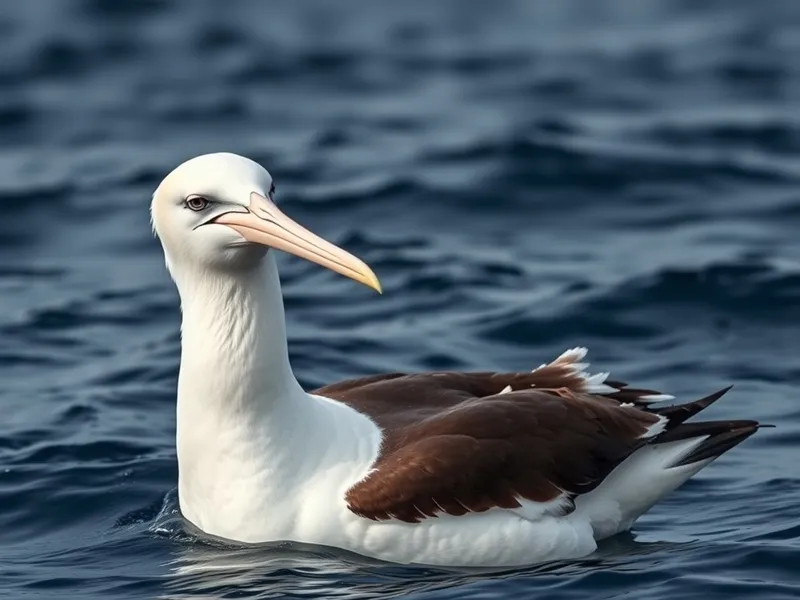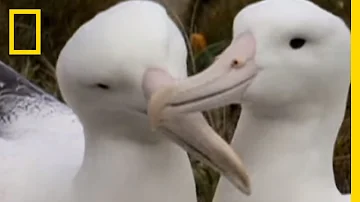
Wandering Albatross
Diomedea exulans

Meet the Wandering Albatross
The Wandering Albatross is renowned for having the largest wingspan of any living bird, often reaching up to 3.5 meters (11.5 feet). With striking white plumage as adults and a robust pink bill, these seabirds are masters of dynamic soaring, spending most of their lives gliding effortlessly over the open Southern Ocean. They are known for their extraordinary long-distance flights, sometimes circumnavigating the Southern Hemisphere multiple times in their lifespans. Wandering Albatrosses breed on remote subantarctic islands, where they form monogamous pairs and invest years raising each chick.
Classification
Bird
Habitat
Open ocean (Southern Ocean), subantarctic islands
Diet
Carnivore
Lifespan
30-50 years
Conservation
Vulnerable
Weight
6-12 kg
📖Fascinating Facts
Longest Wingspan
The Wandering Albatross boasts the longest wingspan of any bird, measuring up to 3.5 meters (11.5 feet) from tip to tip.
Ocean Wanderer
They spend the vast majority of their lives at sea, only coming to land to breed on remote subantarctic islands.
Elaborate Courtship
Pairs engage in complex courtship rituals that involve synchronized dancing, vocalizations, and bill-fencing to strengthen their lifelong bonds.
📋Detailed Description
The Wandering Albatross (Diomedea exulans) is a truly iconic seabird, distinguished by its immense wingspan, which averages 2.5–3.5 meters (8.2–11.5 feet), the largest of any living bird. Adults display predominantly white plumage, with some dark feathers on the wings and tail, while juveniles are more mottled brown and gradually whiten with age. The robust, hooked bill is pale pink and well-adapted for seizing slippery prey. Their long, narrow wings are highly specialized for dynamic soaring, allowing them to travel vast distances with minimal energy expenditure by exploiting wind gradients above the ocean surface. The body length ranges from 107 to 135 cm (42–53 in), and they typically weigh between 6 and 12 kg (13–26 lbs), with males generally larger than females. Wandering Albatrosses are highly pelagic, spending most of their lives far from land, only returning to isolated subantarctic islands to breed. They are monogamous, forming lifelong pair bonds, and exhibit strong site fidelity, often returning to the same nesting area each breeding season. Their vocalizations include a variety of grunts, screams, and bill-clapping, especially during courtship displays. The species is known for its exceptional longevity, with individuals often living over 50 years in the wild. Their slow reproductive rate and long development period for chicks make them particularly vulnerable to environmental changes.
💡 Did you know?
A Wandering Albatross can travel more than 120,000 kilometers (75,000 miles) in a single year!
🔬Research & Sources
Wikipedia Summary
The snowy albatross, also known as the wandering albatross, white-winged albatross, or goonie, is a large seabird from the family Diomedeidae; they have a circumpolar range in the Southern Ocean. It is the largest species of albatross and was long considered to be the same species as the Tristan albatross and the Antipodean albatross. Together with the Amsterdam albatross, it forms the wandering albatross species complex, which some began referring to more recently as "snowy".
Last Modified: 5/23/2025
🎭Behavior & Social Structure
Wandering Albatrosses are solitary foragers but may congregate loosely in areas of abundant food or around fishing vessels. They employ dynamic soaring and slope soaring to cover thousands of kilometers without flapping, enabling efficient long-distance travel over the Southern Ocean. Their diet consists mainly of cephalopods (especially squid), fish, and crustaceans, which they capture at or near the ocean surface, sometimes scavenging carrion or offal from ships. Feeding is primarily nocturnal, aligning with the vertical migration of squid. Social interactions are most prominent during the breeding season, when elaborate courtship rituals—featuring synchronized dances, mutual preening, and bill clapping—help reinforce pair bonds. Outside breeding, individuals are rarely seen together except at rich feeding sites. Daily routines at sea are dominated by foraging and resting on the water, with minimal time spent on land except during nesting.
👶Reproduction & Life Cycle
Breeding occurs biennially, with pairs returning to traditional nesting colonies on remote subantarctic islands such as South Georgia, Crozet, and Macquarie. Courtship is elaborate and may last several years before a pair first breeds. The breeding season begins in December–January, when a single large egg (weighing up to 500 g) is laid in a shallow nest of vegetation. Both parents share incubation duties over a period of 11–13 weeks (approximately 75–80 days). After hatching, the chick is brooded for several weeks, then left alone while both parents forage at sea, returning at intervals to feed the chick by regurgitation. Fledging occurs after 8–9 months, usually in November–December. Juveniles spend 5–10 years at sea before returning to breed, often at their natal colony. The species' low reproductive rate—one chick every two years—makes population recovery slow.
🛡️Adaptations & Survival
The Wandering Albatross is exquisitely adapted for a life of extreme pelagic travel. Its long, narrow wings provide an exceptionally high aspect ratio, minimizing drag and maximizing lift for dynamic soaring in strong oceanic winds. The nasal passages (naricorns) are specialized for excreting excess salt, allowing the bird to drink seawater. Strong, hooked bills facilitate grasping slippery prey. Their plumage is dense and waterproof, providing insulation against cold southern latitudes. Behavioral adaptations include highly efficient navigation and orientation skills, possibly aided by geomagnetic cues and olfactory senses, enabling them to locate food and nesting sites across vast oceanic expanses. The species' delayed maturity and extended parental care are evolutionary responses to the unpredictable and resource-scarce environment of the Southern Ocean.
🎨Cultural Significance
The Wandering Albatross has long captured the human imagination, symbolizing endurance, freedom, and the mysteries of the open ocean. It features prominently in maritime folklore and literature, most famously in Samuel Taylor Coleridge's 'The Rime of the Ancient Mariner,' where the albatross is both a good omen and a symbol of burden. Sailors traditionally regarded the bird with reverence, believing that harming an albatross would bring bad luck. In some cultures, the bird's immense wingspan and solitary journeys have inspired metaphors for exploration and the human spirit.
🔬Recent Research & Discoveries
Recent research using satellite telemetry has revealed that Wandering Albatrosses can travel over 120,000 km (75,000 miles) in a single year, with some individuals circumnavigating the Southern Ocean multiple times. Studies on foraging ecology have highlighted their reliance on squid and the importance of oceanic fronts as feeding grounds. Genetic analyses have clarified relationships within the Diomedea genus, supporting the distinction of several closely related species. Conservation research is focused on reducing fisheries bycatch through bird-scaring lines and weighted hooks, as well as monitoring population trends using long-term banding and tracking programs. Ongoing studies are investigating the effects of climate change on wind patterns and breeding success.
🎥Wildlife Videos

Albatrosses Use Their Nostrils To Fly | Nature's Biggest Beasts | BBC Earth
#BBCEarth Watch more: Planet Earth http://bit.ly/PlanetEarthPlaylist Blue Planet http://bit.ly/BluePlanetPlaylist Planet Earth II ...
BBC Earth

Albatross Love Story | Incredible Animal Journeys | National Geographic
As our oceans become more dangerous, every goodbye could be the wandering albatross' last. Enjoy a free trial of National ...
National Geographic

Albatrosses' Life-Long Bond Begins With Elaborate Courtship – Ep. 3 | Wildlife: Resurrection Island
At over 11 feet, the wandering albatross has the biggest wingspan of any bird on the planet. One of these birds can fly millions of ...
National Geographic

Wings of the Albatross | National Geographic
About National Geographic: National Geographic is the world's premium destination for science, exploration, and adventure.
National Geographic

Nature of Wandering Albatross Birds | David Attenborough | BBC Studios
David Attenborough watches the wandering albatross, a bird of huge size and majesty. From the BBC. This is a channel from BBC ...
BBC Studios

Endangered Wandering Albatross | Saving Planet Earth: Albatross | BBC Earth
Sir David Attenborough explains the wonder of the Wandering Albatross and the concerns over the impact man is having on the ...
BBC Earth
🌍Habitat Information
The Wandering Albatross typically inhabits Open ocean (Southern Ocean), subantarctic islands environments. Wandering Albatrosss have adapted to their environments with specialized features and behaviors.
Primary Habitat:
Open ocean (Southern Ocean), subantarctic islands
More detailed habitat information will be available soon.
🛡️Conservation Status
The Wandering Albatross is currently classified as Vulnerable. Conservation efforts are crucial for preserving this species for future generations.
Common Threats:
- 🏠Habitat loss and fragmentation
- 🌡️Climate change impacts
- 🎯Hunting and poaching
- 🏭Human-wildlife conflict
⚠️Threats & Conservation Challenges
Major threats to the Wandering Albatross include bycatch in longline fisheries, where birds are accidentally hooked and drowned while scavenging bait. Ingestion of marine debris, particularly plastics, poses additional risks. Introduced predators (such as rats and cats) on breeding islands can prey on eggs and chicks. Climate change is altering oceanic wind patterns and prey distribution, potentially impacting foraging success and breeding productivity. The species is classified as Vulnerable by the IUCN, with an estimated global population of 20,000–25,000 mature individuals and a declining trend. Conservation challenges include enforcing sustainable fishing practices, eradicating invasive species from breeding islands, and mitigating the impacts of climate change.
🔬Scientific Classification
Scientific Name
Diomedea exulans
Classification Hierarchy
🔍 About Taxonomic Classification
Taxonomic classification is a hierarchical system used by scientists to classify and organize living organisms based on shared characteristics and evolutionary relationships.
The system moves from broad categories (Kingdom) to increasingly specific ones, with each animal's scientific name typically consisting of its Genus and species.
📝Community Notes
Share your observations and insights about the Wandering Albatross with our community of wildlife enthusiasts.
Join Our Community
Sign in to share your observations and connect with fellow wildlife enthusiasts.
Sign In to ContributeNo community notes yet
Be the first to share your observations about the Wandering Albatross!
Explore Wandering Albatross
Select a tab above to learn more about this amazing animal.
📸Photo Gallery
No photos available for this animal yet.
🌟Discover More Wildlife
Continue your journey of discovery with more fascinating animals from our database
